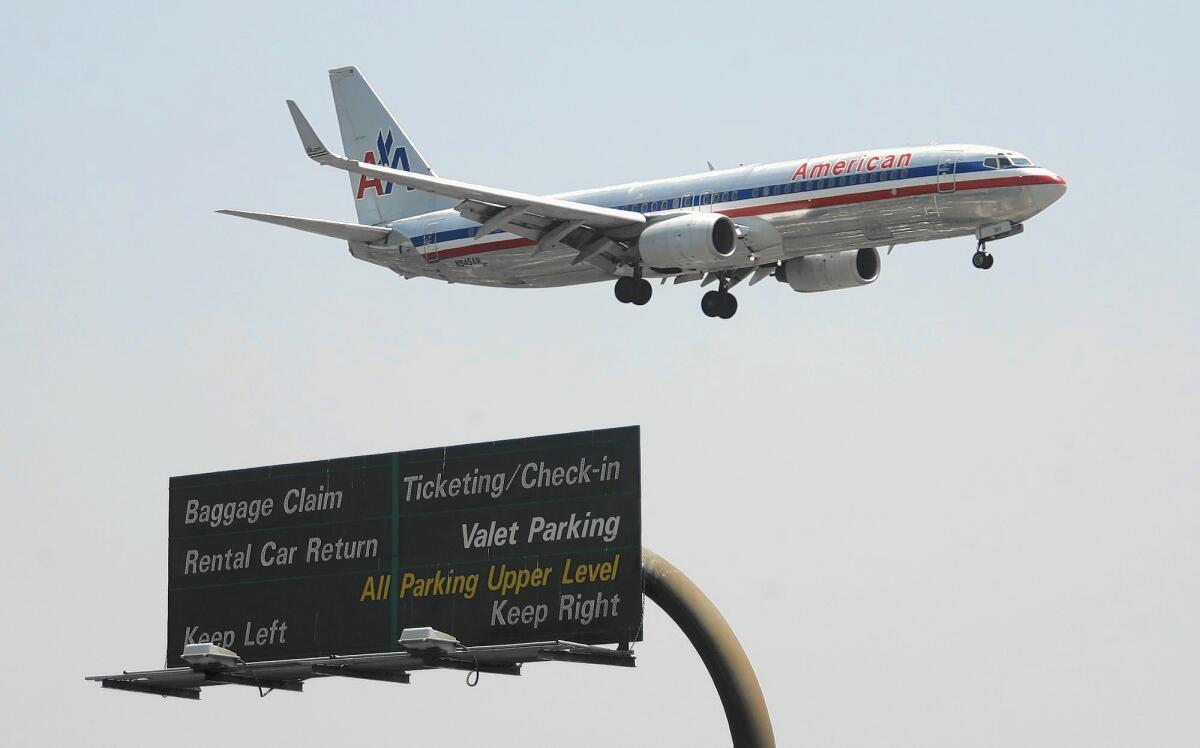Balboa Island residents concerned about airplanes’ pollution and noise

Lee Pearl can hear the rumble from the engines of jets departing John Wayne Airport when he’s sitting on the patio of his Balboa Island home.
Before he equipped the windows and doors on his two-story home with double-paned glass, he heard it inside too, he said.
“We’d have to turn up the TV every time a plane flew over,” he said.
Residents of Balboa Island, Peninsula Point and other Newport Beach neighborhoods have lived with planes flying over their homes for years. Recently their concerns have been heightened by a Federal Aviation Administration proposal to narrow flight paths at 11 Southern California airports, including John Wayne, which sits on unincorporated land adjacent to Santa Ana, Irvine and Newport Beach.
The possible change is part of the FAA’s efforts to replace traditional ground-based air traffic procedures with satellite-based technology at those airports.
The agency believes the Next Generation Air Transportation System could save fuel, reduce emissions and delays and shorten flight times by establishing flight plans that are less dispersed than they have been.
Most of the planes that depart from John Wayne Airport follow a route that takes them across Upper Newport Bay before bisecting Balboa Island and the end of the Balboa Peninsula and turning around a few miles over the ocean.
Under the current system, the pilot has more control of the takeoff route. Under the new system, a precise takeoff path can be programmed into the plane’s flight plan.
Some Balboa Island residents are concerned that if the FAA’s plan is put in place, flights will become even more concentrated over their homes, potentially causing increased pollution and noise.
“The NextGen systems using GPS has increased the accuracy of the departures to keep planes in their exact lane,” the Balboa Island Improvement Association wrote in a letter to the FAA. “This technology may actually be increasing the negative environmental impacts on those directly under the departure pattern.”
The FAA’s draft environmental assessment of the project shows no significant or reportable pollution or noise effects.
The city of Newport Beach has voiced its support for the FAA keeping its historical flight paths, including flying over Balboa Island, which has angered some residents.
Terry Janssen, president of the Balboa Island Improvement Association, said this is the ideal time to voice concerns to the FAA.
“This is the only time we’re going to have the FAA here communicating with us,” he said. “I find it difficult to understand why the city would want to impact more than 8,000 people.”
Janssen and other community associations are asking the FAA to consider allowing planes to use navigation technology to make a right turn, staying completely over Newport Bay before crossing the Balboa Peninsula around Sixth Street. Janssen and Pearl say the route would be safer than flying over land with a high number of residents.
The plan was outlined in a 2013 city-commissioned report that was later submitted to the FAA with little success, Mayor Ed Selich said.
“They responded to us in June of that year and said that it didn’t work because it doesn’t follow their current criteria for departure design,” Selich said. “It doesn’t mean that someday in the future it won’t happen, but it wouldn’t be appropriate for us to try to push for that.”
Airplane noise and pollution concerns are not new to many communities in Newport Beach.
Decades ago, the city, John Wayne Airport, Orange County and two community groups entered an agreement that established a flight curfew and limits on noise and the number of passengers and departures. The noise-abatement agreement stemmed in part from residents’ complaints. In 2014, the parties extended the agreement through December 2030.
As part of the pact, the county established seven noise monitors along the airport’s departure corridor. For years, air carriers used noise-abatement procedures during departures, such as ascending rapidly and “throttling back” the engine when flying over homes. More recently, planes have technology that reduces the sound of the engines, and many airlines no longer need to use the abatement measures to meet sound requirements.
By the time planes fly over the peninsula and Balboa Island, they are no longer being monitored for sound, making the agreement unhelpful for mitigating noise in those areas, according to city documents and residents.
Proposing changes to flight paths is challenging for the city, Selich said, because it has little control or input over the FAA’s plans. The city also has an interest in maintaining a positive relationship with the FAA to ensure that the settlement agreement is unchanged and that the agency continues to listen to the city’s concerns, Selich said.
“If you try to save Balboa Island, you’re going to impact everyone else,” he said. “You pit neighborhoods against one another that way.”
Pearl and Janssen said the plan they’re advocating would reduce noise and safety risks for the city as a whole, not just Balboa Island.
“It’s what’s in the best interest for the majority of Newport Beach,” Pearl said.